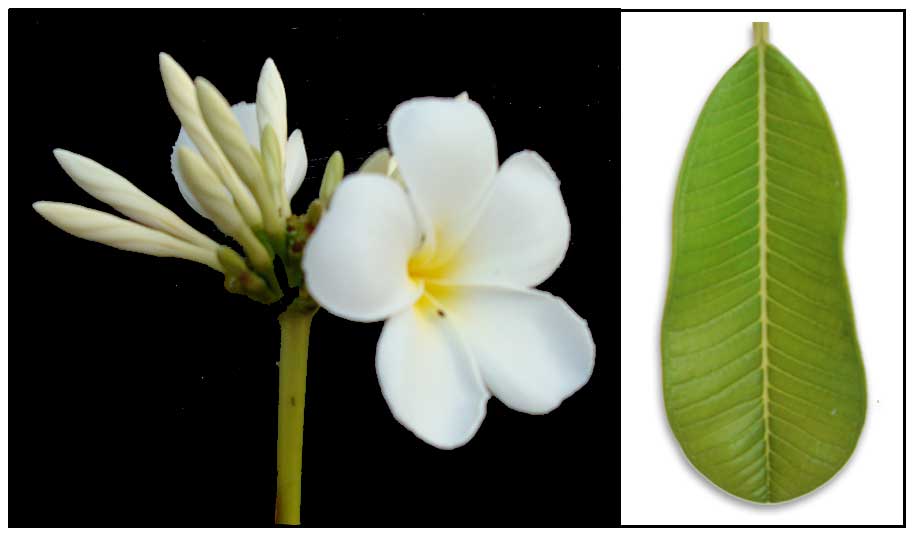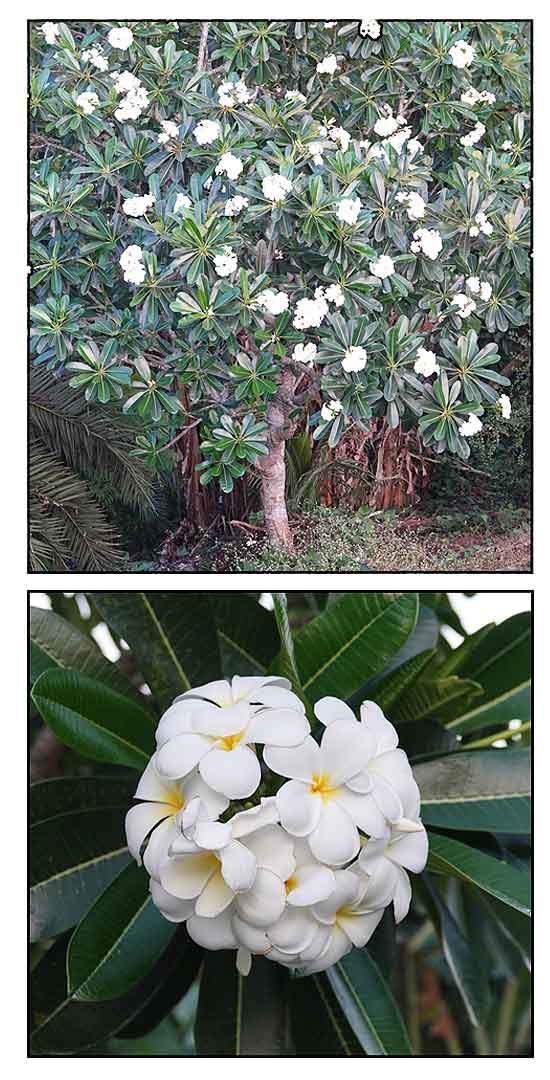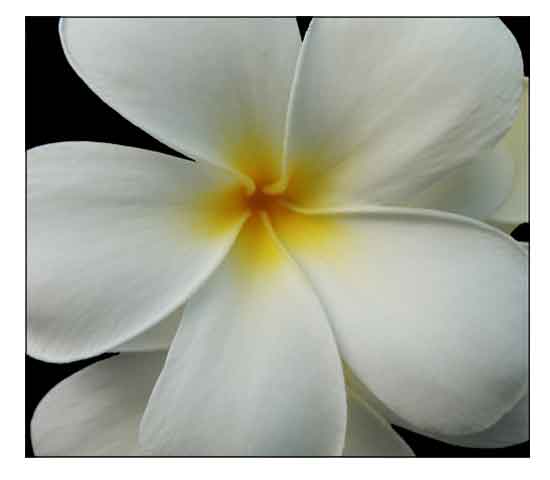|

Gen info
- Revised taxonomy: The genus Plumeria of the Apocynaceae family was revised to contain P. rubra, P. obtusa, and their hybrids. Plumeria acuminata, P. acutifolia, and P. lutea, previously species names, are now recognized as botanical forms of P. rubra. (16)
- Study reports on the key to 40 major plumeria cultivars grown in Hawaii, which is based on the most prominent color in the petal: reds, pinks, yellows, white, and blends.
(16)
- Etymology: The genus name is in honor of 17th-century French botanist and Catholic monk, Charles Plumier, botanist of King Louis of France. The species epithet derives from Latin obtusa meaning 'blunt', referring to the blunt-tipped leaves.
- The common name, Frangipani, is likely rooted in Italy, a family bearing the name Frangipani traces back to an ancestor whose job was to refill the wafers or holy bread in church. Frangipani means "broken bread", from frangi meaning to break and pan meaning bread. (24)
-
The source of the common name "Frangipani" is convoluted. One, that it comes from the 16th-century marquis of an Italian noble family who claimed to have invented a plumeria-scented perfume, although it was a synthetic perfume resembling the odor of fragrant flowers. Another, from the fictional hero Mercutio Frangipani, a botanist on one of Columbus' voyages, who discovered the New World shoreline through his extraordinary sense of smell attracting them to shore. It was George Piesse, in fact, who formulated the synthetic scent he named 'Frangipanni' in 1880, under the guise of the story of the Marquis de Frangipani. (24)
- In some parts of South East Asia, the tree and flower are considered sacred. Balinese Hindus use the flowers as temple offerings.
- The two Plumeria species in this compilation are Plumeria rubra (P. acuminata, P. acutifolia, Kalachuchi) and P. obtusa (white kalachuchi, Kalatsutsing-puti). P. obtusa leaves are pointed and oval, up to 18 centimeters long, with tubular flowers. P. rubra produce fragrant flowers with five spreading petals, yellow to pink, with oval or lance-shaped leaves 20 to 30 centimeters long.
- The frangipani is the national tree of Laos, called dak lampa, and where it is regarded as a sacred tree. It is also the national flower of Nicaragua.
 Botany Botany
Plumeria obtusa is a shrub or small tree growing up to 5 meters tall. Branches are thick, succulent, widely spaced, and covered with knobby protuberances. Stems and leaves yield a milky sap. Leaves are dark green, leathery, obovate to oblong-obovate, up to 30 centimeters long, with conspicuous parallel secondary veins running from the mid-vein, and clustered near the tips of the branches. Flowers are white, five-lobed, with a yellow center, borne in clusters at the end of the branches.
Distribution
- Introduced.
-
Widely cultivated in the Philippines.
- Native to tropical America.
Constituents
- Neutral N2 fraction of methanolic extract of fresh, undried and uncrushed leaves of Plumeria obtusa isolated a new lupane triterpenoids (1) along with five known compounds viz., obtusaline, betulinic acid, oleanolic acid, ursolic acid, kaneroside and oleandrin. (3)
- N3 neutral fraction yielded 10 new compounds (11-13, 15-19, 22, 23) together with 8 known compounds (7-10, 14, 20, 21, 24) isolated for the first time from this species, viz., α-amyrin (7) neriucoumaric acid (8), isonericoumaric acid (9), alphitolic acid (10), obtuscin (11), oytusinin (12), obtusilin (13), 3b.23-dihydroxyurs 12-en.28 oic acid (14), obtusidin (15-19), 27.p-Z.coumaroytoxyursolic acid (20), 27.p--E.coumaroytoxyursolic acid (21), coumarobtusanoic acid (22) coumarobtusane (23) and oleanonic acid (24). (3)
- Study of flowers for essential oil yielded 21 compounds viz., linalool, (Z)-geraniol, (Z)-citral, (E)-geraniol, (E)-citral, (Z)-beta-farnesene, (E)-beta-farnesene, 1-hexadecene, 2-methylpentadecane, alpha-farnesene, (Z)-farnesol, (E)-farnesol, (E)-farnesal , benzyl benzoate, 1-octadecanol, benzyl salicylate, eicosane, unknown1, unknown2, (E)-farnesyl acetate, and heneicosane. (see study below) (4)
- Phytochemical screening of various extracts of leaves yielded sterols, alkaloids, favonoids, terpenoids, glycosides, with absence of saponins. (see study below) (7)
- Study of fresh leaves yielded two new iridoids viz., 6″-O-acetylplumieride p-E-coumarate and 6″-O-acetylplumieride p-Z-coumarate, and three known iridoids viz., plumieride, plumieride p-Z-coumarate and plumieride p-E-coumarate. (8)
- Oil of Plumeria obtusa was found rich in benzyl salicylate (45.4%) and benzyl benzoate (17.2%), with only minute concentrations of alkanoic acids. (12)
- Phytochemical screening of stem bark extract yielded triterpenoids, flavonoids, carbohydrate, essential oil, glycosides and alkaloids. (see study below) (13)
- Ethanolic extract of bark yielded alkaloids, flavonoids, tannins, and terpenoids. (see study below)
(14)
Properties
- Fragrance is especially intense at night to attract pollinating moths. In the morning, many flowers drop off. (22)
-
Considered purgative, vulnerary, pectoral, hemostatic.
- Milky latex is regarded as poisonous or irritant in India, however information related to toxicity of extracts is limited.
(see study below) (23)
- Studies have shown antimicrobial, antiproliferative, antioxidant, insecticidal, wound healing, antiulcer, anti-inflammatory, anticarcinogenic properties.
Parts
utilized
Flowers, bark, leaves.
 Uses Uses
Edibility
· Caution / Toxicity: While some blogs have reported Plumeria flowers to be edible (eaten raw in salads or steep in tea), many advise against ingestion. All parts are considered toxic. The sap can cause a rash in sensitive people. The alkaloid content makes the plant extremely bitter, Ingestion may cause stomach pains and cramping. (19)
Folkloric
· No reported folkloric medicinal use in the Philippines.
· Used for blenorrhagia, boils, herpetic lesions, sores, syphilis, and wounds. Used as cicatrizant, pectoral, purgative and hemostatic.
· Used in the treatment of diabetes, asthma, gonorrhea, and constipation; also, as contraceptive, expectorant, and anthelmintic.
(7)
· In Cambodia, bark decoction used as purgative; also used as remedy for edema.
· In the Sekhukhune District of South Africa, decoction of leaves taken three times daily for diabetes. (9)
· In Asia, decoction of leaves used for treating wounds and skin diseases. Bark and latex used as diuretic and purgative. (10)
· In Ghana, stem bark used as antimalarial.
· In Thailand, decoction of wood used for leprosy and ulcers. In Uganda, leaf sap or powder used for herpes zoster. In Indonesia, sap and skin used for treatment of boils and toothache. In India, latex and root juice used as abortifacient. (23)
Others
· Ornamental / Ritual: In Cambodia, flowers are used to make necklaces; used in ritual offerings. In some Pacific Islands, such as Tahiti, Fiji, Hawaii, Samoa, New Zealand, plumeria flowers used for making leis.
· Oils / Perfumery: Essential oil used as ingredient in cosmetics, candles, potpourri, massage oils, and aromatherapy.
· Social indicator: In modern Polynesian culture, women use the frangipani as social indicator: over the right ear signals seeking of a relationship, and over the left if taken. (18)
· Superstitions: Some Malay Muslims believe that the tree's habit of dropping flowers in the mornings represent an offering of flowers to the dead. So, Indian and Malay Muslims and Buddhists often plant the species in graveyards. In Singapore, there is a reluctance for its ornamental use because of the association of the white flowers to funerals and graveyards. (22) In the Philippines, there are niches of similar superstition with advice that ornamental cultivation augurs the likelihood of being left by loved ones.
Studies
• Essential Oil / Flowers: In various scented compound extraction methods using P. obtusa flowers, the major chemical component in the essential oils from all distillation methods and solvents was benzyl salicylate. Extracts from cold and hot enfleurage were linalool and n-undecanoic acid, respectively. Isolation of frangipani absolute by hexane extraction was considered the most appropriate method at pilot scale for extract use in perfume and cosmetic materials. (see constituents above) (4)
• Antimicrobial / Flowers: Study evaluated various solvent extracts from flowers of P. obtusa for antimicrobial activity against a broad spectrum of human pathogenic organisms. The extracts showed variable degrees of inhibition of all microorganisms. Among gram positive bacteria, the most susceptible was B. subtilis, the most resistant S. aureus. Among gram negative bacteria, the most susceptible was Eriwina carotovora, the most resistant P. aeruginosa. (5)
• Antimicrobial / Leaves: Study evaluated various solvent extracts of leaves of P. obtusa for antimicrobial activity. Results showed PE, iso-butanol and EA fractions showed inhibitory activities against all nine microbial species except K. pneumonia and P. aeruginosa. (6)
• Antioxidant / Leaves: Study evaluated the phytochemical constituents and antioxidant potential of a methanol extract and fractions of P. obtusa leaves. Results showed moderate dose-dependent antioxidant activity based on DPPH and lipid peroxidation inhibition assays. (see constituents above) (7)
• Antiproliferative / Leaves: Study evaluated leaf extracts of 10 Apocynaceae species against three human cancer cell lines (MCF-7, MDA-MB-231, and HeLa). Plumeria obtusa was one of six plants that showed positive growth inhibitory activity, with ≤50% cell growth. The n-hexane extract of P. obtusa inhibited MCF-7 and HeLa cells. (10)
• Insecticidal / Leaves: Study evaluated the insecticidal efficacy of two Plumeria species (P. rubra and P. obtusa) foliar extracts on mosquito and beans weevil populations. P. obtusa yielded mosquito mortality rate of 86.2% and weevil mortality of 90%. while P. rubra was 88.75% and 95%, respectively. Results suggest potential applications in public health pest and disease management, food preservation and crop protection. (11)
• Antiulcer / Stem Bark: Study showed gastroprotective effects of P. obtusa stem bark extracts in peptic ulcer induced by pylorus ligation and indomethacin. The ulcer healing effects could be due to reduction in gastric acid secretion, gastric cytoprotection and proton pump inhibition. (See constituents above) (13)
• Wound Healing / Spray Formulation of Leaves: Study evaluated the wound healing activity of an ethanolic extract of Plumeria obtusa leaves in 2.5% , 5%, and 10% (F1, F2, F3, respectively) spray formulations in in-vivo wound healing models in white Wistar albino rats. In excision wound model, F3 showed complete wound healing on day 17, while F1 and F2 showed complete healing on day 21 and 19, respectively. In incision wound model, the F3 spray exhibited high tensile strength. Results showed F3 extract spray showed better and efficient wound healing activity compared to F1 and F2. (14) Study evaluated the wound healing activity of ethanolic extract of Pl obtusa leaves spray in an in-vivo excision model in white Wistar albino rats. Results showed the 10% extract spray had better and more efficient wound healing activity than the 5% extract spray. (20)
• Anti-Inflammatory / Bark: Study evaluated the anti-inflammatory effects of ethanolic extract of bark of Plumeria obtusa using animal models of cotton pellet method and carrageenan induced paw edema in male Wistar rats. Results showed highly significant (p<0.001) dose-dependent anti-inflammatory activity in both models. (see constituents above). (15)
• Ursolic and Oleanic Acids Mixture / Antioxidant / Anticarcinogenic Potential to Melanoma Cells: Study evaluated the antioxidant and anticarcinogenic potential of oleanolic acid (OA) and Ursolic acid (UA) on B16 murine melanoma cell line isolated from P. obtusa, free and loaded in a nanoemulsion (NEm) system. The OA/UA natural mixtures exhibited high % of inhibition of DPPH with or without irradiation. The natural mixture incorporated into the NEm showed cytotoxic activity from 2.9 µM, whereas the free compounds from 17.4 µg. Results conclude the pentacyclic triterpene loaded in a NEm system has potential as new tool for further investigation as anticancer agent. (17)
• Protective Effect / Dexamethasone-Induced Insulin Resistant Diabetes / Leaves: Study evaluated the protective effect of P. obtusa leaf extract on dexamethasone-induced insulin resistant diabetes. Treatment significantly improved serum levels of glucose, glycosylated hemoglobin and insulin, along with lipid profiles. (21)
• Acute Toxicity Study / Leaves: The milky latex is regarded as poisonous or irritant in India, however information related to toxicity of extracts is limited.
Acute toxicity study of P. obtusa ethanolic leaf extract at doses of 250, 500, 1000, and 2000 mg/kbw orally in Swiss albino Wistar rats showed no mortality or toxicity up to 72 h. (23)
Availability
- Ornamental cultivation.
- Frangipani essential oil int he cybermarket.
|

![]()

